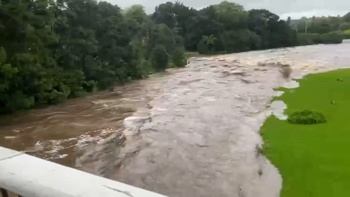A major new study has delivered a grim prognosis for our postcard glaciers. But, as science reporter Jamie Morton explains, the tragic story of our vanishing ice isn't complete yet.
If we thought of Aotearoa as an art gallery, the glaciers adorning its southern spine would be its greatest exhibition.
We're awed by Franz Josef Glacier/Kā Roimata o Hine Hukatere, with its frozen mass of white tumbling down the western side of the Southern Alps, and nearby Fox Glacier/Te Moeka o Tuawe, a crumpled blanket of pure blue, hugged by Westland's rugged green valleys.
There's Haupapa/Tasman Glacier, snaking along beneath the high gaze of the Aoraki/Mt Cook National Park's sawtooth peaks, or the Brewster, perched just above its own brilliant turquoise meltwater pools.
Then there's the Ivory, a tiny jewel of a cirque glacier at the head of the breathtaking Waitaha Valley.
It's a remnant of what it was when Trevor Chinn took a keen interest in it back in the 1960s.
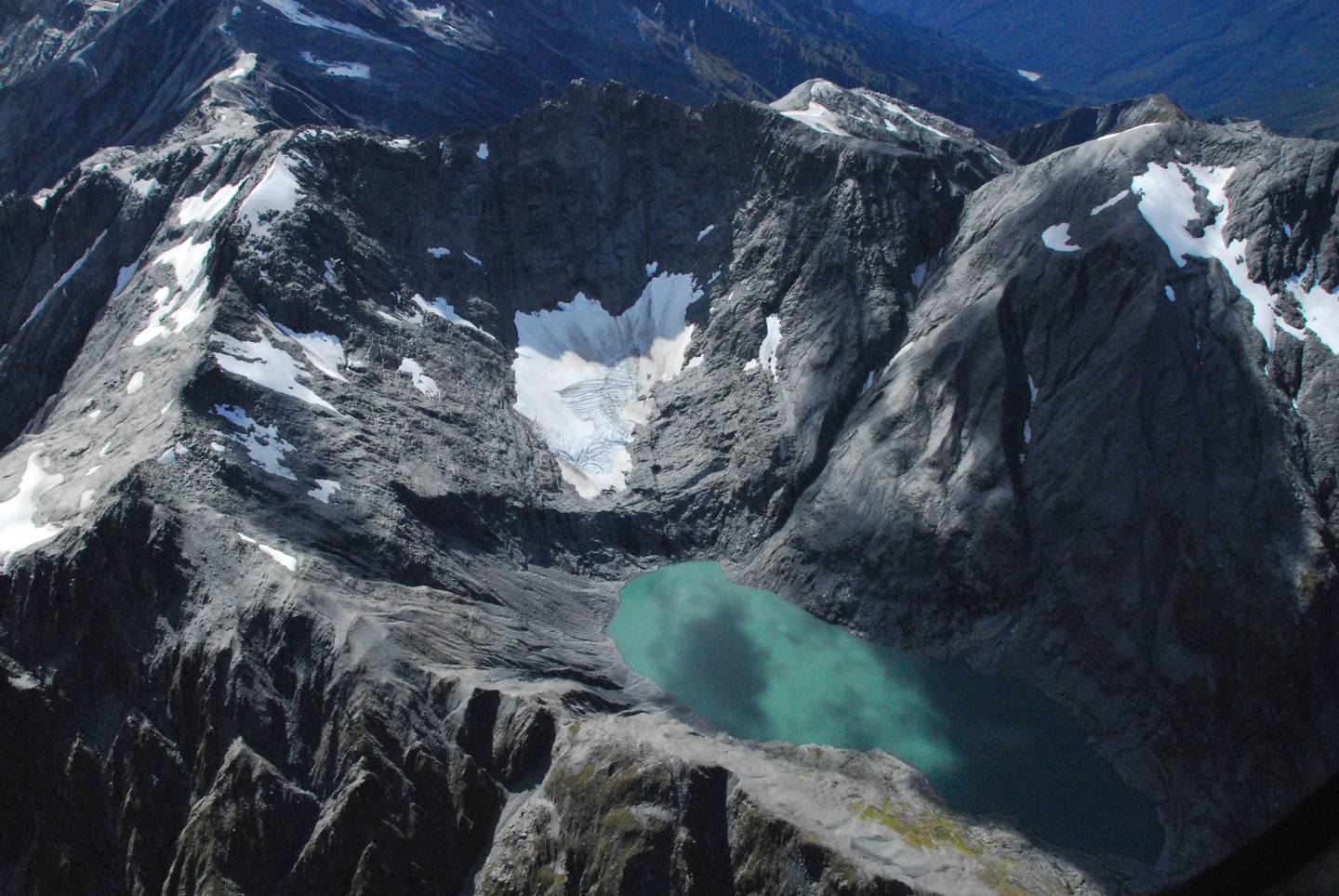
Westland's Ivory Glacier, as pictured in March. Photo / George Macara
The great glaciologist picked it as a handy yardstick to track ice mass balance in the region.
A decade later, he began cataloguing some 3140 glaciers across the South Island as part of a global science effort, before selecting a subset of 50 to keep tabs on each year.
It's with this invaluable glacier index that we've been able to chronicle one of our largest environmental tragedies.
A warming climate has stripped the Southern Alps of a third of their ice.
Within just a decade, many of our postcard glaciers might be found only in the photographs of Chinn's record.
Victoria University glaciologist Associate Professor Huw Horgan thought of that art gallery analogy: but instead pictured the empty hall that future generations of trampers and climbers might be met with instead.
"All of the pictures have been taken down off the walls and all that's left is the imprint on the wallpaper," he said.
"That different shade that lets you know something was there – but all you get is the ghost of it."
A legacy of loss
When Chinn died in 2018, at the age of 81, his annual snowline survey had been running 40 years.
He often pointed out how glaciers – the sum of a range of climate components, from temperature to precipitation and sunshine – offered perfect barometers of change.
And the launch of his index, checked by a charter plane filled with scientists each autumn, happened to come at a turning point.
"From the 1860s to the 1960s, people in Aotearoa had the opportunity to witness, study and simply enjoy big glaciers in un-modified alpine landscapes," said his son, Department of Conservation ecologist Warren Chinn.
"Since the 1950s and 60s, our glaciers began shrinking quickly and a generation of people who witnessed and knew the size of these glaciers will soon be gone too."
It's true that our landscapes have been transformed by climactic shifts before.
Dramatic moraine ridges tell the story of enormous glaciers that sculpted the alps in the last ice age, reaching their greatest extent 18,000 years ago.
Seven millennia later, in tandem with a cold snap across Antarctica, they pushed down-valley again, before suddenly pulling back. As recently as the 18th Century, a "Little Ice Age" brought the Franz Josef into rainforest.
But the change we're seeing today has been packed into much smaller timeframes.
The 1.2C of temperature rise observed in fewer than 150 years compares with 5C to 6C that was spread over thousands of years since the last ice age.
"In contrast, at present rates of anthropogenic greenhouse gas emissions, we might expect such a jump in temperatures to occur within just a couple of centuries," Victoria University glaciologist Dr Shaun Eaves said.
Was there any precedent?
"This is a tricky line of work as glaciers are very good at telling us about cold events in Earth's history, but past ice minima are much less obvious," Eaves said.
"Nonetheless, using state-of-the-art techniques, we have yet to find any convincing evidence that New Zealand glaciers have ever been smaller than present in recent geological history."
A decade of melt
The sheer scale of what we've lost already is difficult to comprehend.
Otago University's Associate Professor Nicolas Cullen estimated that, between only 1978 and 2020, glacier volume shrank from 53.3 cubic kilometres to 34.6 cu km – or by about 35 per cent.
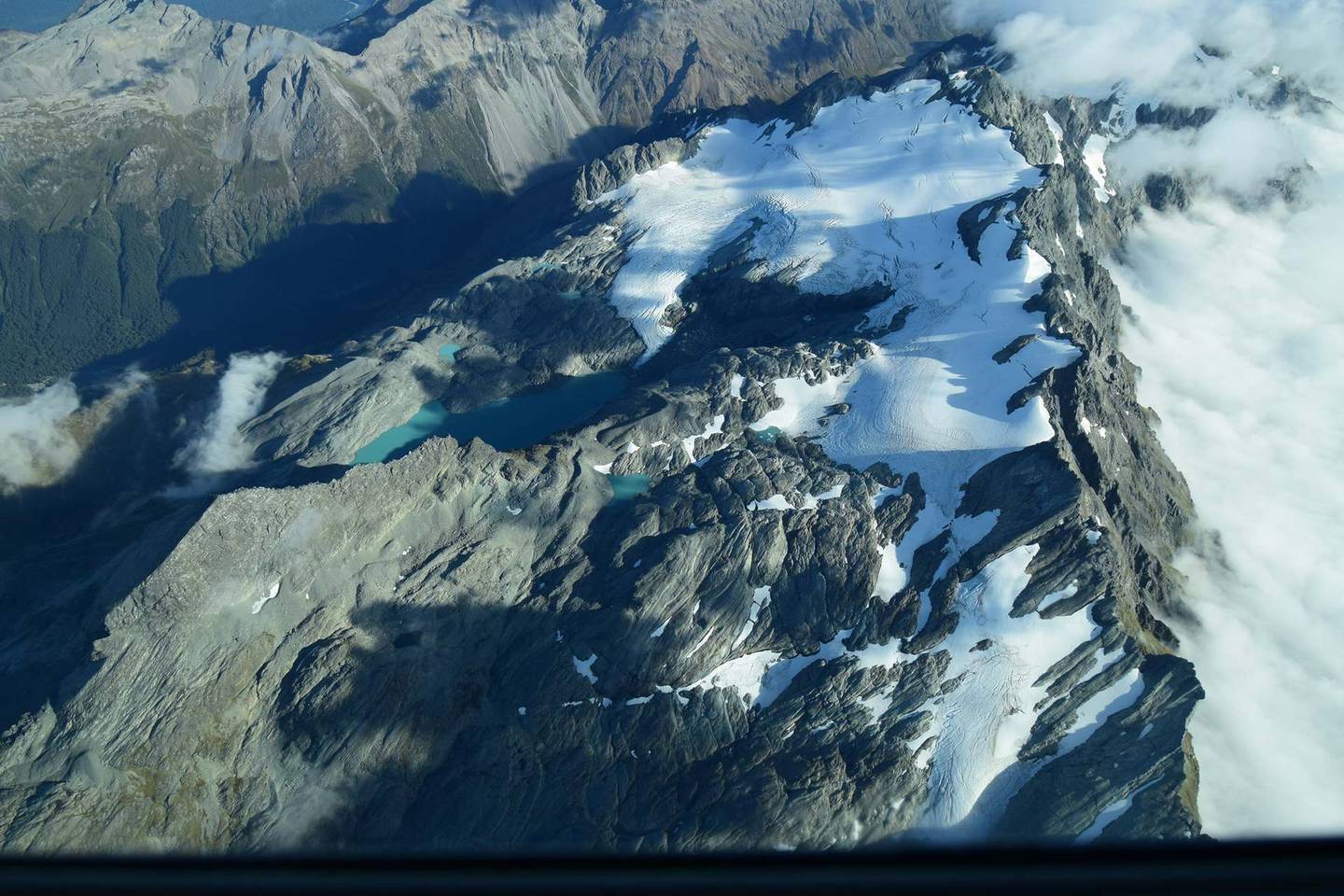
Park Pass Glacier in Mt Aspiring National Park, as viewed at the end of summer. Photo / Warren Chinn
"Some really big melts from really warm years have been increasing in frequency this past decade," Niwa climate scientist Dr Drew Lorrey added.
"We can see the impacts on the snowline flights by looking at glaciers that appear absolutely shattered relative to the previous year."
Recent research led by Victoria University glaciologist Dr Lauren Vargo has linked years with the highest levels of ice loss to man-made emissions, finding that global warming made the extreme ice loss observed in 2018 at least 10 times more likely.
Lorrey singled out the effect of marine heatwaves – another event last summer pushed sea temperatures in some regions to record readings – in the ongoing melt.
Warmer water in the Tasman Sea meant hotter local air temperature on land – which was then carried up to altitude where it ate into the bank of snow and glacier ice stored from previous years.
But it wasn't the only driver.
"We also see an association with more northerly air flows through time and diminished influences from the southern westerly winds," Lorrey said.
"The situation has changed in a way that has brought increased warmth to our region, but we also see impacts for the marine area directly upstream from the Southern Alps that can hang around for a while.
"Our glaciers are really intimately connected to the Tasman Sea."
More broadly, an indicator of westerly wind position called the Southern Annular Mode, or SAM, has been increasingly trending positive – and driving a poleward shift of westerly winds.
"We know that's not good for our glaciers, because positive SAM usually brings warmer and drier conditions to the Southern Alps," he said.
"This mode of climate works in unison with La Niña episodes to reinforce all those conditions that are typically poor for our glaciers."
While scientists are still learning about the influence human-driven warming might be having on natural variability in our climate system, Lorrey and colleagues have shown how these two factors could at least work in concert to cause melting.
Over the 1980s and 1990s, one well-studied phenomenon called the Interdecadal Pacific Oscillation (IPO), which switched back and forth every 20 to 30 years, actually diminished the impact of warming.
Since 2000, however, it's been unfortunately working in the same direction – and Lorrey expected the future fluctuation wouldn't be enough to repair the damage.
"For many New Zealand glaciers, which are small, I do not believe the occasional cool year interspersed with warm ones like we are experiencing with greater frequency will be enough to either undo the recent damage or grow glaciers back to their former size at any time in the near future," he said.
"Some of the glaciers we have monitored since the late 1970s won't be seen again under the current trajectory of climate warming."
Even if we saw winter snowfalls akin to the past, he said, much of that would be falling on bedrock rather than ice.
"When we observe how hot some of the bedrock gets over summer, using a thermal camera, it leaves no doubt that the potential for that snow to eventually transform into ice is very low."
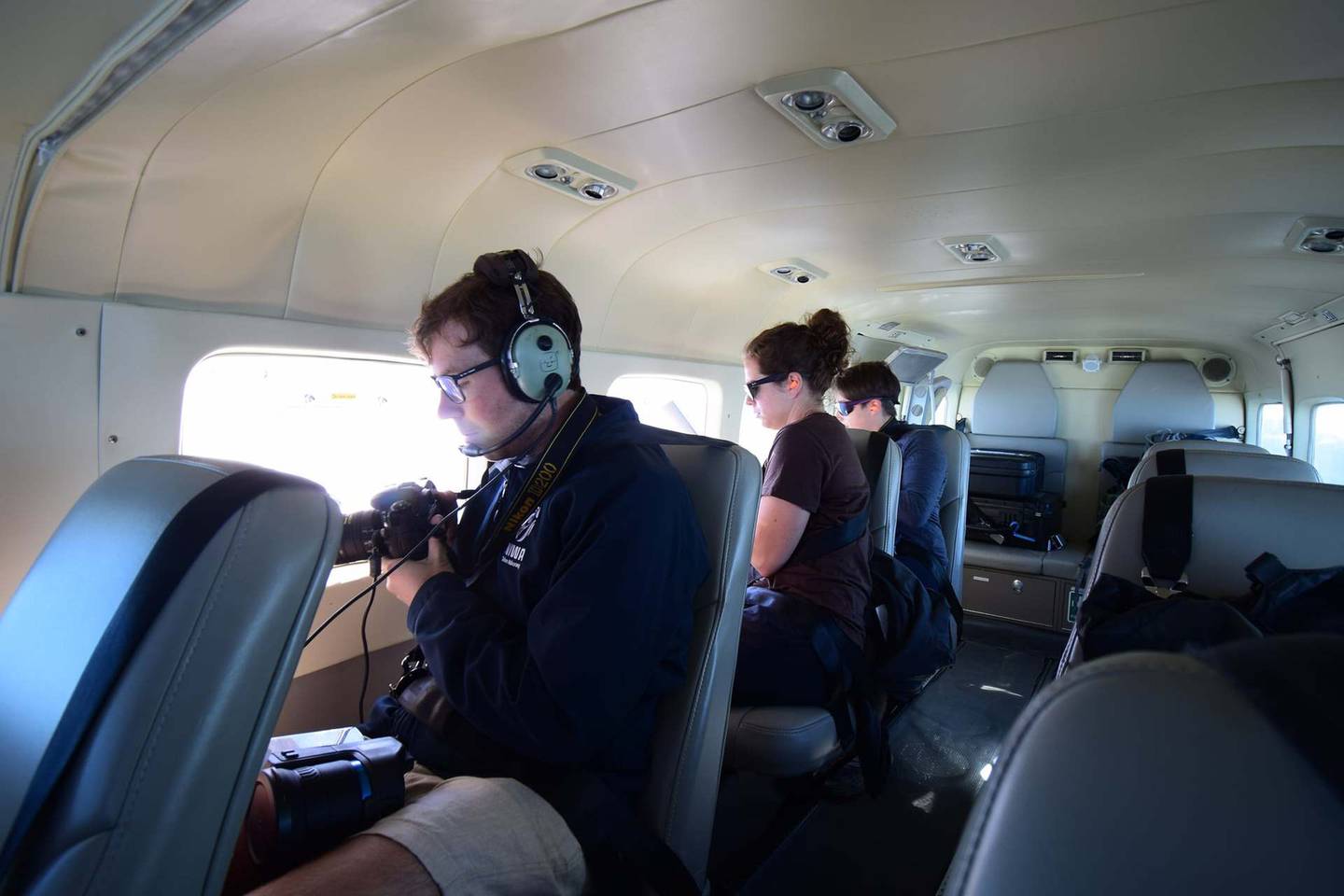
Scientists take part in this year's end of season summer snowline survey. Photo / Warren Chinn
For smaller glaciers – three quarters of New Zealand's happen to measure less than 100,000sq m – the prospects of replenishing lost ice were particularly poor.
"Small glaciers are disappearing and this becomes a moot question - glaciers that are no longer present would take decades to regrow and this seems unlikely," Monash University glaciologist Professor Andrew Mackintosh said.
"The only glaciers that will potentially fluctuate in length in response to annual to decadal climate variability are the ones that retain intact accumulation zones such as Fox and Franz.
"For these glaciers I expect to see long term retreat interspersed with occasional re-advances – but never back to where they were."
A new normal
Just as scientists have had to redefine what now constitutes "average" temperatures, they've also adapted Chinn's original inventory of glaciers to our new normal.
Eleven of the original 50 are expected to disappear by the middle of next decade, with another 10 swiftly approaching a similar fate.
An updated record developed by Lorrey and colleagues now spans from 1977 to 2020, using photographs that show how snowline elevation has shifted relative to where it was between 1981 and 2010.
"We used this 30-year period as a reference datum because a wide range captures years with high and low snowline positions," Lorrey explained.
"Some years are good, others are poor, and some are near normal – and the reference period we chose contains all three types."
Each glacier also had a different sensitivity to climate, which could depend much on where ice was located, how large or small the glacier was, and in which direction it was facing.
By comparing snowline changes against the datum and other data they had, they could calculate precisely what each glacier was doing.
"The technique we used transformed the snowline elevations into something called standard deviation units, and this lets us look at year-to-year variations of glaciers of different size from across the Southern Alps in a more comprehensive way," Lorrey said.
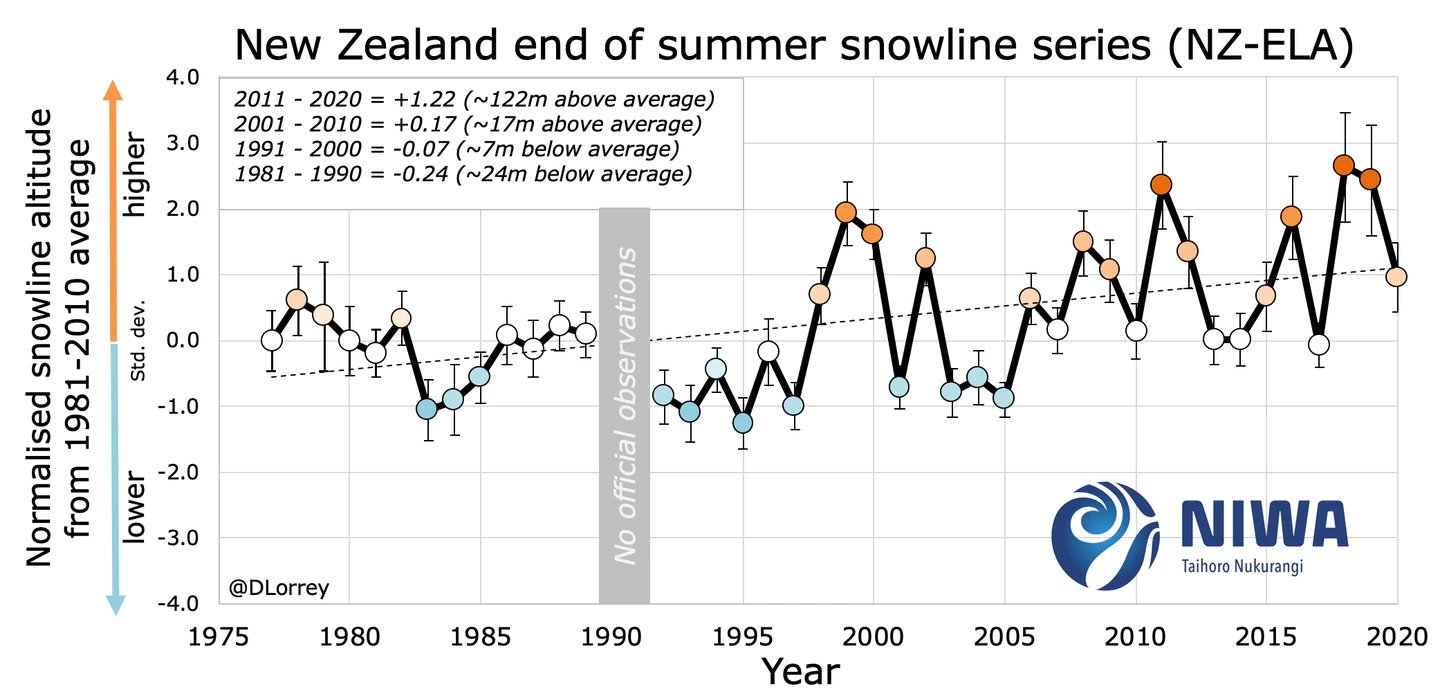
This graph shows how the average snowline of the Southern Alps has risen over time. Image / Drew Lorrey, Niwa
His team has also been photographing ice at higher elevations to better capture the seasonal snowline, while also looking for new glaciers to replace fading ones in the record.
"The edges of our survey in and near north Canterbury, Southland, Otago and Fiordland have some glaciers that were in the original survey in the 1970s that are now totally shot."
They included the Faerie Queene, Wilson and Franklin glaciers in the north and Caroline Peak, the Merrie Ranges and Mt Irene in the south.
"There's no need for us to head out to those spots anymore," Lorrey said.
"Some of the glaciers we still include between the decent ice we have, like on the Browning Ranges and Carrington Peak, are well on their way to extinction."
Still, the survey wasn't any less important today than it was four decades ago.
"Often in science we lament the lack of continuity in observations," Niwa climate scientist Gregor Macara said.
"The closure of a weather station location can introduce inhomogeneity into the observational record, which in turn brings complexity when identifying climate change trends.
"So, there's a real need to ensure the continuity of the survey. It has incredible value in documenting the changes that are occurring and will continue to occur."
A grim forecast
A major study published last week boiled down all that the scientists have been able to learn over recent years.
It found that, if contemporary decadal trends continued, the alps' average snowline elevation would be displaced at least 200m higher than normal, as early as 2025 to 2034.
The research also refined the links between ice loss and specific climate trends.
"We see the strongest correlations for the snowline to warm season temperatures for the central Tasman Sea and South Island west of the main divide," Lorrey said.
"From our view, it looks like the last decade had a significant ramping up for the rising trend of the snowline that matched rising temperatures."
Vargo said we could already get a good steer from Niwa's seven-stations temperature record, in which the average climbed by around 0.4C between 1981 and 2010.
"This is high, especially when we think about Paris Agreement goals of limiting warming to 1.5C above pre-industrial levels," she said.
"That around a quarter of that warming occurred in 30 years, shows how quickly temperatures have risen."
Along with heat-driven melt, climate change also brought other effects that hurt our snowlines: even ash carried across the Tasman from Australian bushfires could help speed up the process.
Then there were knock-on effects of the melting itself.
"We're seeing a number of more localised feedbacks associated with the current rapid glacial recession," University of Canterbury glaciologist Professor Heather Purdie said.
"For example, thinning ice exposes more rock, and that rock is prone to erosion, this leads to an increase dust and debris on the snow and ice surface which in turn increases surface melt."
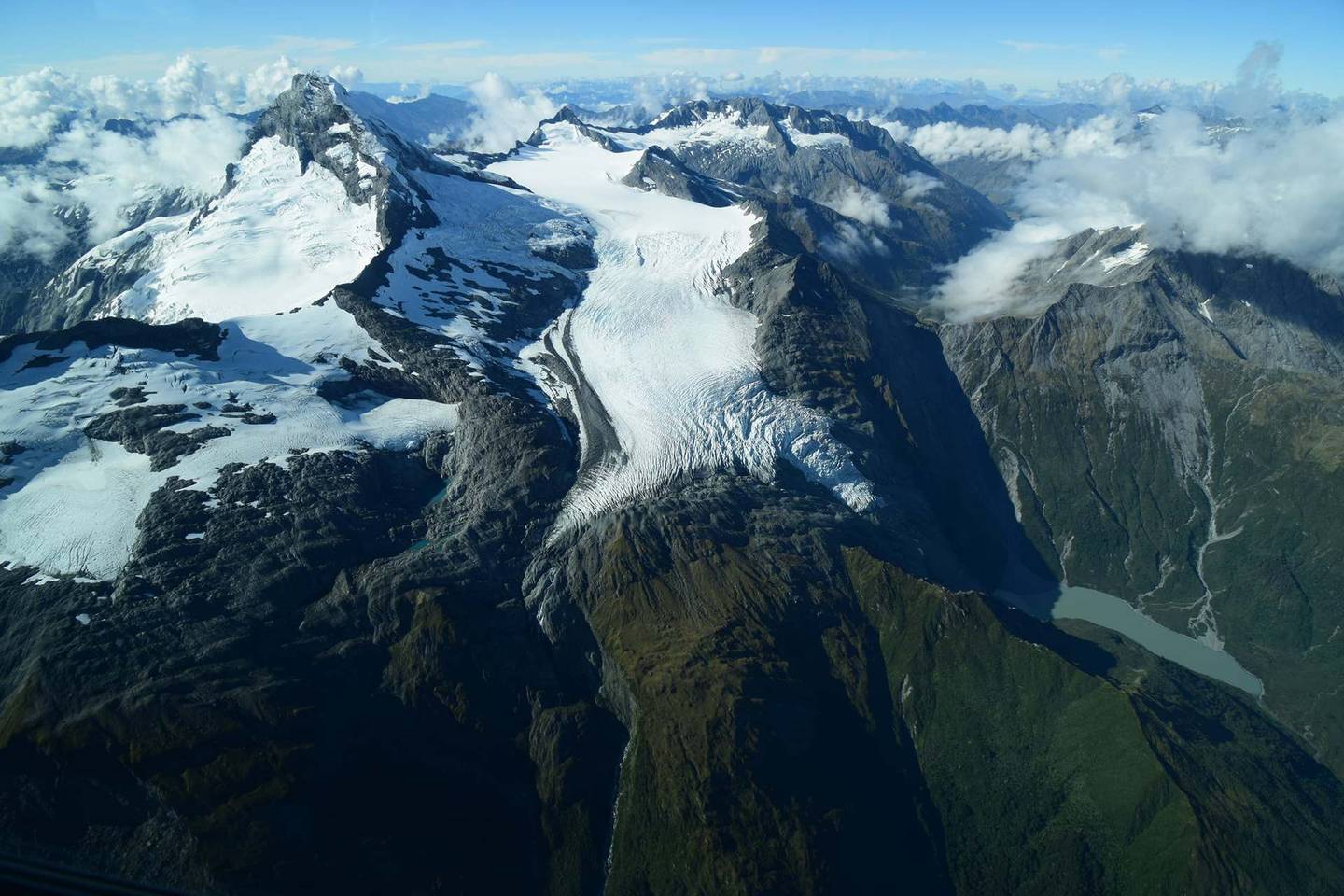
Bonar glacier on Tititea/Mount Aspiring, as it appeared at the end of summer. Photo / Warren Chinn
"Proglacial lakes are developing and expanding and once formed they can drive rapid recession through iceberg calving processes."
But while the thermostat has been cranked toward warming temperatures, scientists didn't think it was too late to save the glaciers.
"The future trajectory of ice loss is still under our control - because of the fast response of many of our glaciers only 19 per cent further ice loss is committed under the present climate in the Aoraki region," Victoria University glaciologist Associate Professor Brian Anderson said.
"More realistically, if we can reduce greenhouse gas emissions quickly, and limit warming to 2C above pre-industrial, we lose 50 per cent of our glacier ice."
But if we did nothing, and allowed the climate to warm by 4C, we stood to lose about 92 per cent.
"It's a stark choice, and it's important to realise that what we do now will make a huge difference to the future outcomes for these glaciers."
An environmental crisis
We often think of glacier loss in dollar terms: after all, they're an international draw which, before the pandemic, happened to attract a fifth of the country's visitors.
Entire tourist communities like Franz Josef and Fox Glacier have been built around them, and the retreat that's already occurred has forced operators to move from taking guided tours to helicopter flights.
But the cost of their demise would be far more than the $120m they annually contribute to the economy. Purdie pointed to the role they played in regulating our streams and rivers.
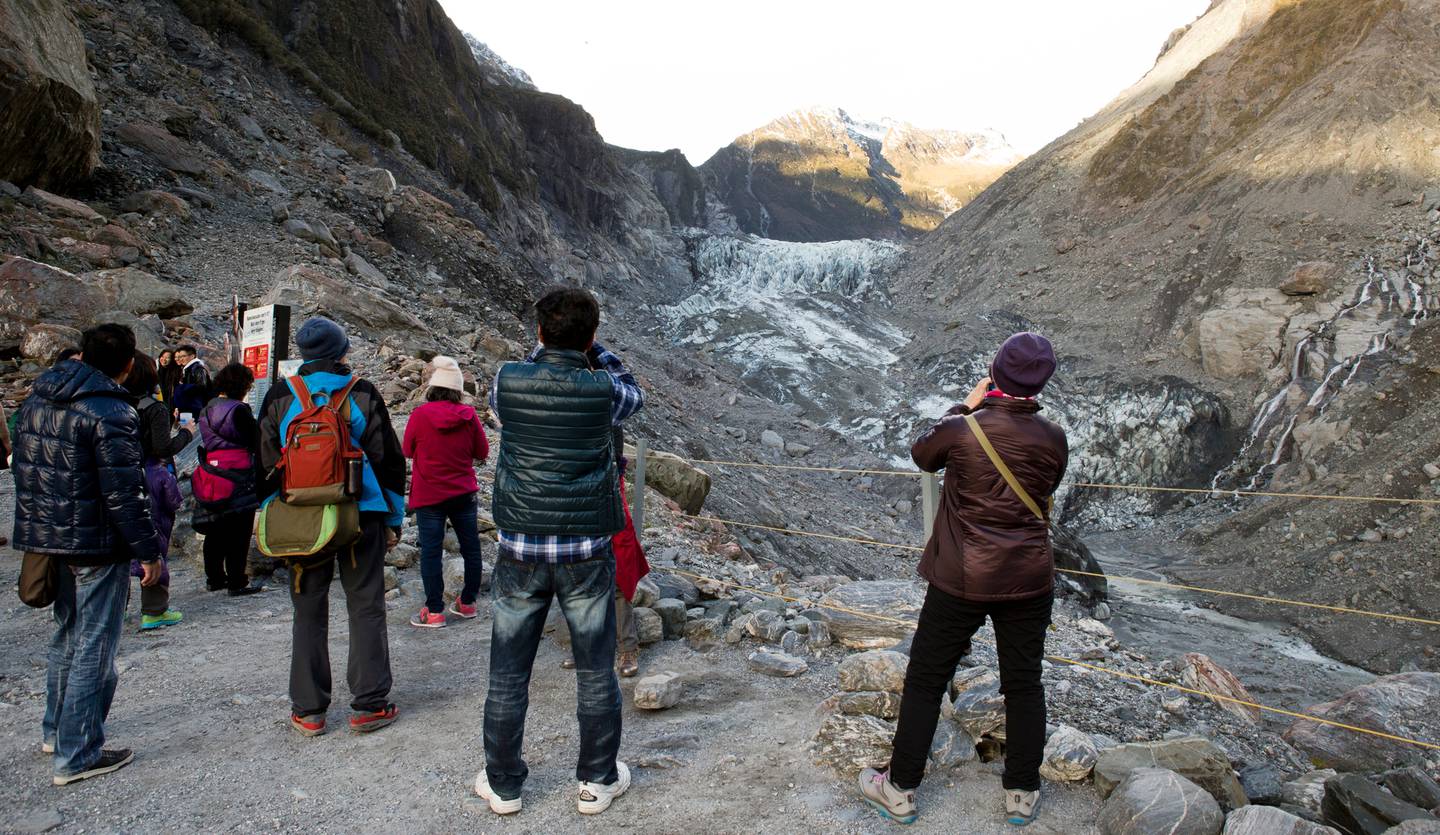
Before the pandemic, glacier tourism annually added around $120m to our economy. Photo / Mark Mitchell
"Having a glacier at the top of your catchment plays an important role in the way in which water is delivered to the rivers," she said.
"Glaciers provide a base-flow to rivers and add more water at times when we need it most: in summer, the peak melt season."
Cullen said we could expect "significant changes" to the hydrological regimes of snow-fed rivers this century, with big implications for hydroelectric schemes.
That would come in tandem with other climate-driven shifts.
"Recent hydrological modelling of the Clutha River, which is New Zealand's largest river catchment by area, demonstrates there could be substantial increases in hydroelectric output in winter and spring, followed by reductions in summer and autumn," he said.
"The driving controls behind this are an increase in winter precipitation, a reduction in the solid fraction of precipitation and an increase in extreme precipitation events."
Our alpine environment also supported a range of unique species, many of which were now under serious threat.
"For the first time since the 19th century, the ice volume and extent of glaciers has receded to a state in which lower and northern alpine areas are dominated by bare rock and new cirque basins," Warren Chinn said.
While we could expect vegetation to fill spots once covered in ice, that could take decades – and in the meantime, our mountains would simply appear drier and rockier.
For alpine ecosystems, Chinn added, the response was more subtle.
"Some organisms will survive by adaptation... others may be forced off the top of mountains."
A vanishing taonga
For mana whenua who hold a profound, centuries-long connection with the glaciers, the impact is being felt in a different way.
Long before Europeans arrived here, Māori lived in a world set against large glaciers reaching into native forests, where they were easily visible and accessible.
The maunga, along with the snow and ice blanketing them, today remain an important part of their āhuatanga, or characteristic.
"As an iwi, we are concerned about the gradual loss of the glaciers over time," Te Rūnanga o Ngāi Tahu Kaiwhakahaere (chair) Lisa Tumahai said.
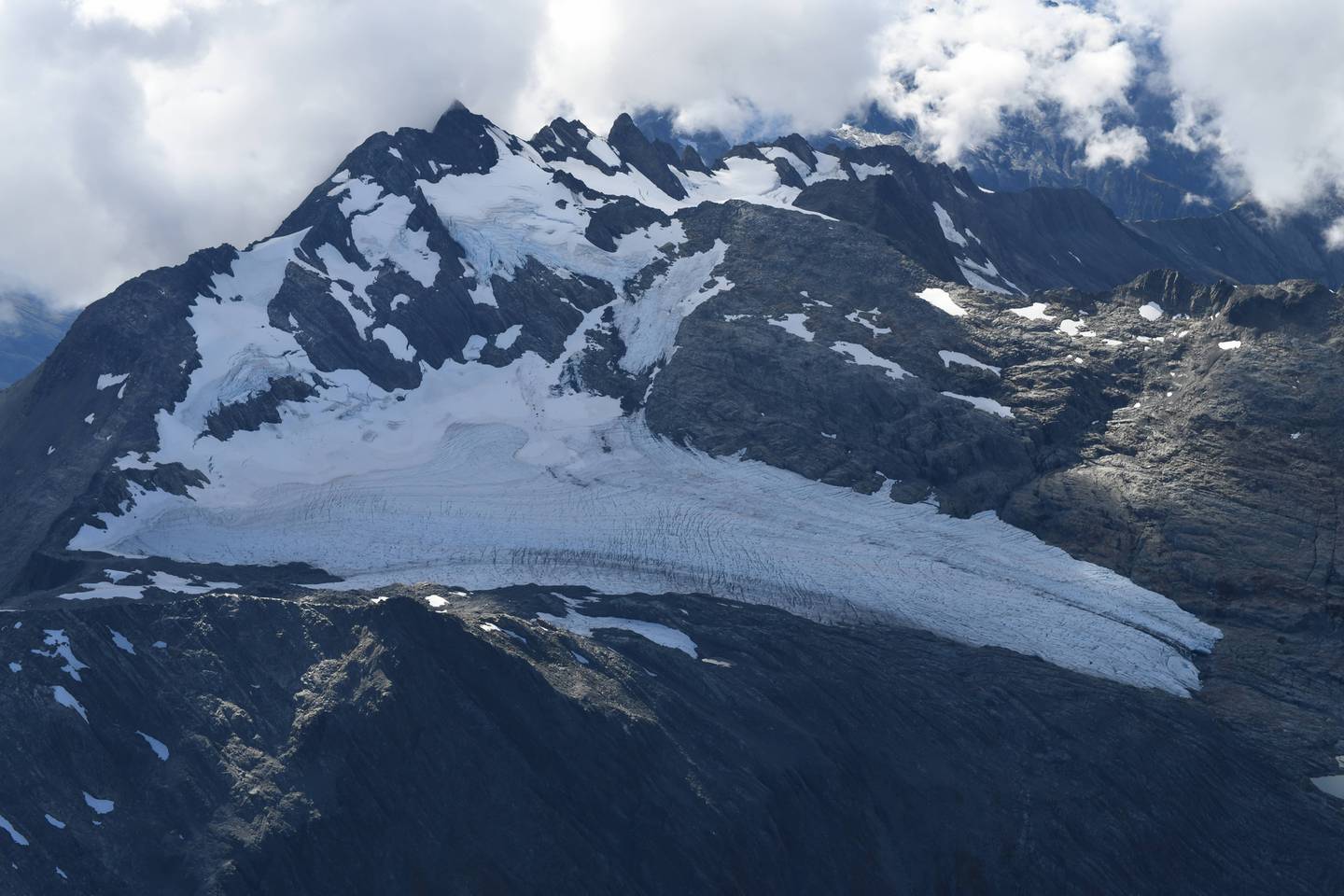
The Brewster Glacier in Mt Aspiring National Park. Photo / Lauren Vargo
"Our tīpuna [ancestors] could never have imagined there would be a time when the glaciers would no longer exist, and that is unfortunately the future we are possibly facing.
"They would be shocked to see the state of the glaciers today, and in another 10 years' time the landscape could be unrecognisable."
Tumahai said the people of Te Tai Poutini, or the West Coast, were immensely familiar with the various trails and passes running through its mountains – and the highways we drove today were once traditional pathways for Ngāi Tahu tīpuna.
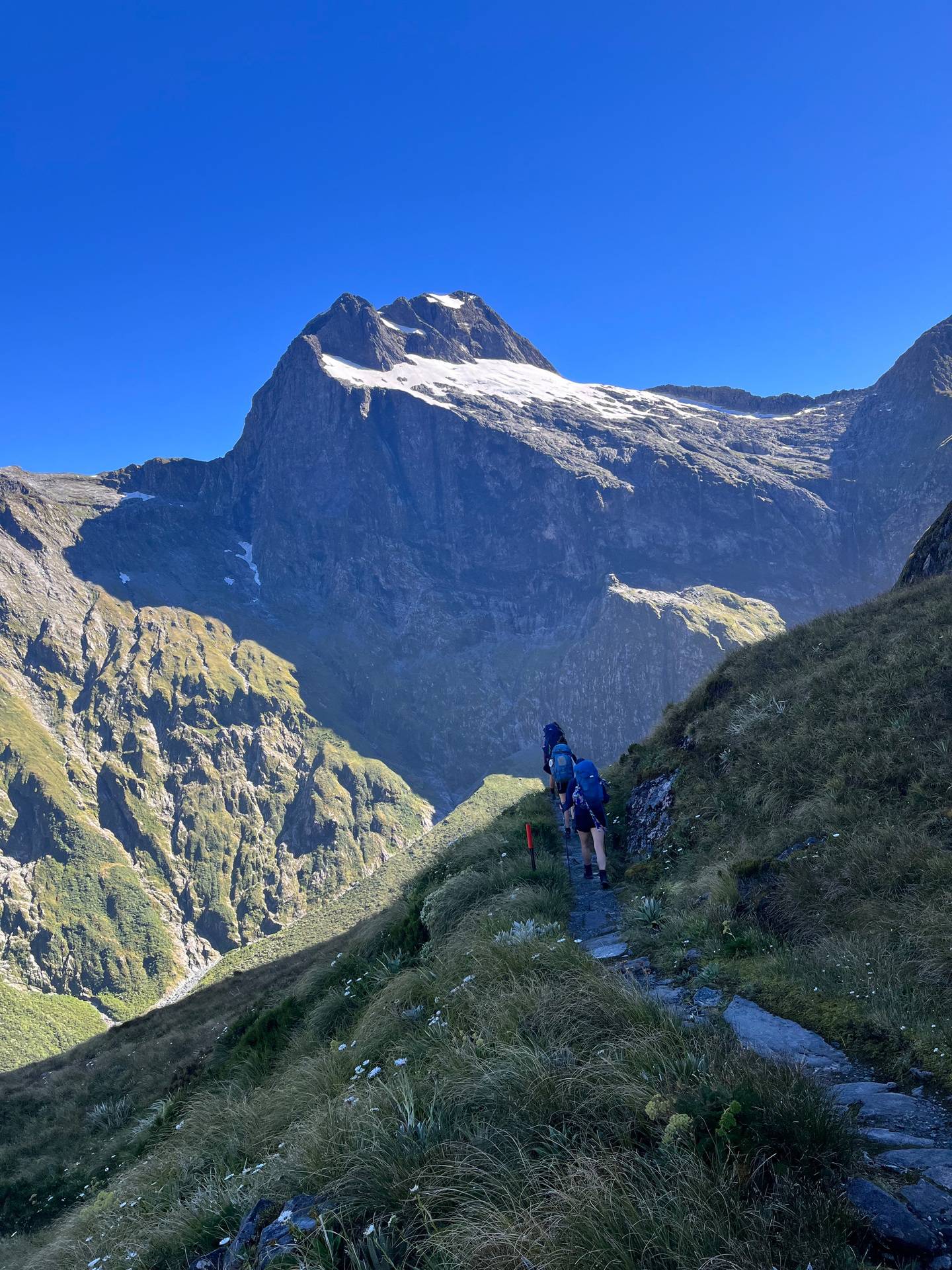
Trampers make their way across the MacKinnon Pass on the Milford Track, towards the Jervois Glacier. Photo / Thomas Bywater
"Some of our most iconic walks such as Nōti Hinetamatea (Copland Pass) trace the original tracks of our tīpuna," she said.
"For example, Nōti Hinetamatea follows the route of the Makaawhio ancestor Hinetamatea and her sons Tātāwhākā and Marupeka.
"One of my twin eight-month-old mokopuna is named Raureka, after the first person recorded to have traversed over Kā Tiritiri-o-Te-Moana [the Southern Alps] bringing pounamu to Waitaha/Canterbury."
The path Raureka discovered was known as Nōti Raureka (Browning Pass).
How were mana whenua reconciling with the changes under way?
"Mana whenua are kaitiaki of our rohe, and we don't just look at one part of an ecosystem in isolation," Tumahai explained.
"The glacier retreat is a visual marker of climate change, and it indicates the overall ecosystem isn't healthy."
"The glaciers cloak the whenua - and while the glaciers may lose their kākahu, it doesn't mean we are less connected to the whenua or our tīpuna."
Their stories would always remain, she said.
"While the glaciers may sadly no longer exist in the lifetime of our mokopuna, our kōrero will continue to document the changes to our natural world for future generations, so lessons can be learned."
Ngāi Tahu also commissioned a report from Niwa as part of its climate change strategy, which she said helped understand what was coming and how best to prepare.
An unfinished script
Te Waipounamu, or the South Island, of course isn't the only place where glaciers are in trouble: those on Mt Ruapehu are in big trouble too.
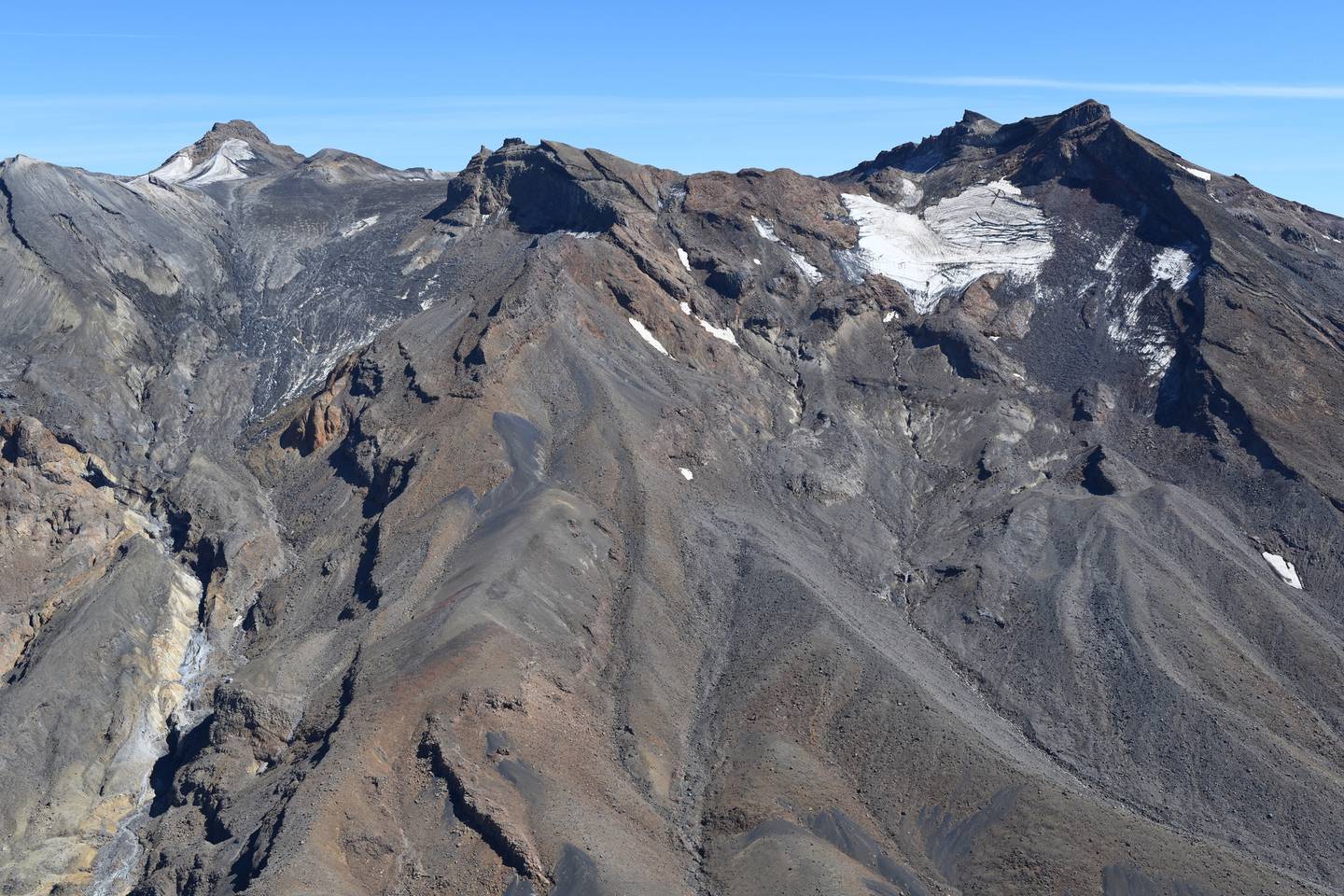
The Mangatoetoenui (right) and Whangaehu (left) glaciers on the northeast side of Mt Ruapehu. Photo / Shaun Eaves
Like some southern glaciers like the Tasman, Ruapehu's glaciers bear a high level of surface debris cover, but in this case sourced from earlier eruptions.
"This rocky debris may slow down melt rates, but we've seen multiple instances in recent years where the winter snowpack has been entirely removed from the summit region," Eaves said.
"If the supply of snow remains cut off, then further glacier decline is inevitable."
Vargo added that, in northern regions particularly, glaciers would fade in step with snow cover.
To her, studying these changes left her all the more worried for the future.
"Glaciers and glaciated landscapes are beautiful, the feeling of exploring and working on the ice is refreshing and awe-inspiring, and glaciers are important culturally, and for water resources and tourism," she said.
"But what's scarier to me than glaciers melting is knowing all of the other impacts of climate change.
"It makes me wonder what it will be like to live 40 years from now if temperatures keep rising as quickly as they have been."
Lorrey saw the shifts as a "really visible and tangible" element of the impacts climate change could bring within just one human lifetime.
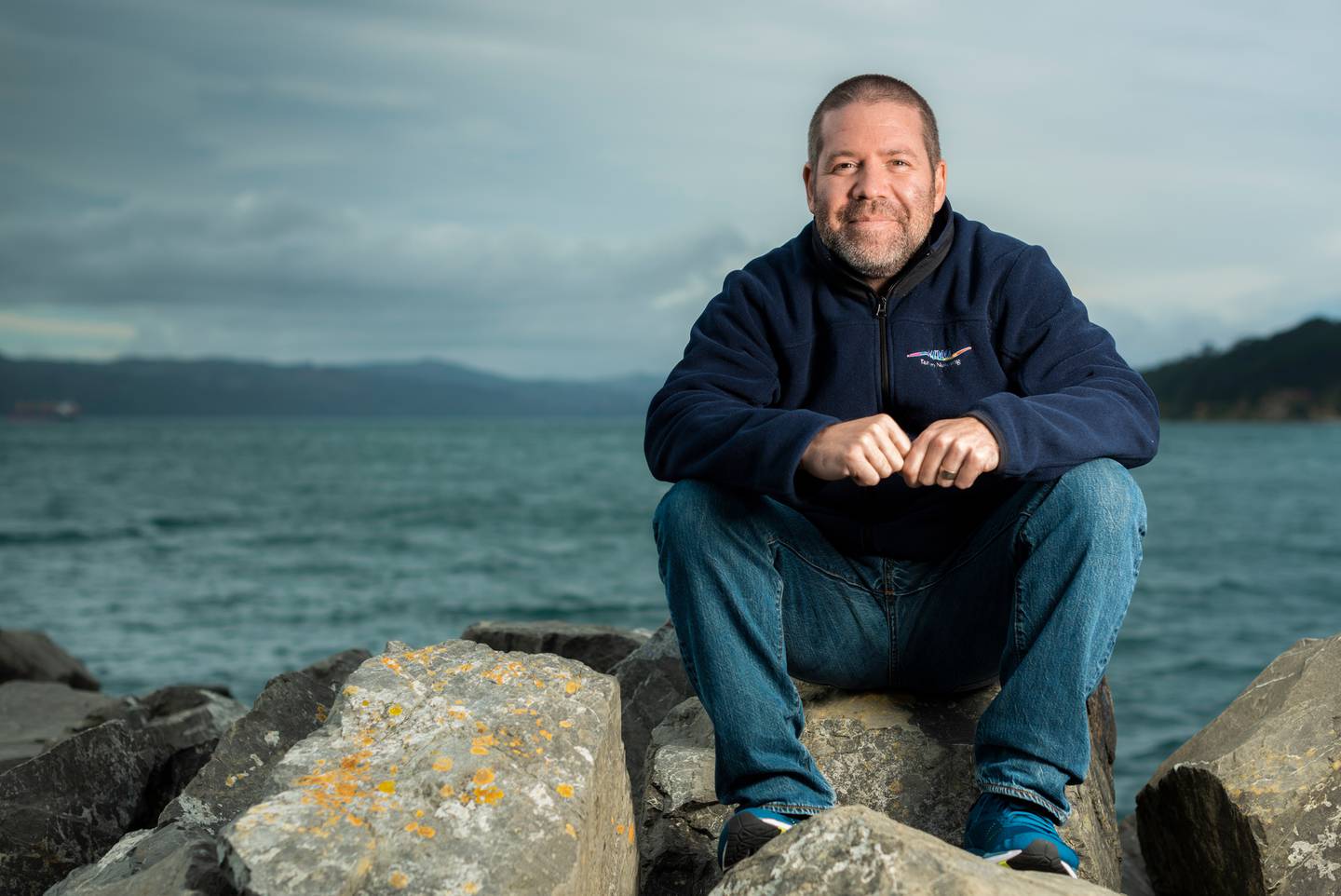
"The changes are undoubtedly going to get even bigger," Niwa climate scientist Dr Drew Lorrey says. Photo / Dave Allen, Niwa
"Other changes for the hydrological cycle, for our biosphere, the land we rely on for living and for the wider world are occurring, but they may be less visible to the public," he said.
"The summer snowline is exhibiting 'escape velocity' traits; it's going at a screaming pace up the side of the mountain and slipping out of our reach.
"We have to ask if that part of our environment is disappearing into thin air, then what else is in store for our climate that we can't easily see?"
Projections could tell us what the most likely outcomes were on our current path, he said, but we still needed to remind ourselves that the warning signs from our glaciers meant big changes were really happening right now.
"The script is not fully written," Lorrey said.
"The changes are undoubtedly going to get even bigger and hit a lot of different elements of our lives much harder if we don't choose to do something about it urgently."
Take your Radio, Podcasts and Music with you






